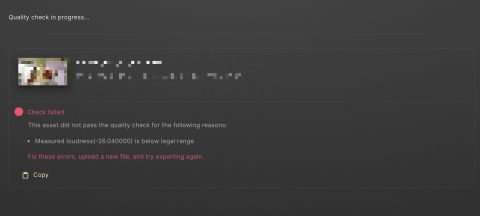Preventing loudness errors during sound relay
Ensuring Seamless Audio Integration: A Guide to Avoiding Common Pitfalls
In our line of work, delivering content that aligns with specifications is paramount. To achieve this, we've implemented an extensive array of checks. However, when providing audio to accompany visuals, a sound relay is essential - placing the audio beneath the visuals. Unfortunately, last-minute, stressed calls often reach us just before deadlines due to audio non-compliance. Typically, uploaders encounter warnings like the one below:

Naturally, these calls come to us as the audio providers, but the root cause often lies in improper audio placement within the visual content. I personally recommend thoroughly checking all incoming audio for assurance, using a simple, free tool like Magnetron's EBU-R128 recipe.
Noteworthy Discrepancies:
A common observation is a 3LU difference between standard and provided sound levels. This discrepancy often arises from converting a mono file to stereo or vice versa. In the example screenshot, the audio is 3LU softer, indicating a loss—possibly caused by incorrectly placing a stereo audio file on a mono channel, resulting in one channel being lost.
Sometimes, the audio becomes unexpectedly louder. This typically occurs when the left and right audio, instead of being distinct, are combined to the center, resulting in a 3LU volume increase.
Understanding Specifications:
It's crucial to note that certain specifications require audio layers to be delivered differently than expected. For instance, in Dutch SPOT delivery, a commercial must always consist of 8 mono channels, even with stereo audio. The channels should be arranged as follows:
- Stereo:
- 1 = Left Stereo
- 2 = Right Stereo
- Surround:
- 3 = Left Front
- 4 = Right Front
- 5 = Centre
- 6 = LFE
- 7 = Left Surround
- 8 = Right Surround
In this example, stereo be placed in two mono channels instead of a single stereo channel. (as a side note, even if there is no surround, those 6 channels should be present, but silence).
Editorial Challenges
Often, the 3LU difference is approximate due to inherent differences between left and right channels. However, instances of significant volume alterations have occurred. When creating a sound relay with editing programs like Resolve, Avid, or Premiere, various factors can impact audio, such as a mispositioned fader, an unintended plugin, or an extraneous audio clip. It would not even be the first time an editor found the audio a bit soft and just raised the levels.
Best Practices
Considering these challenges, one might question the use of an editing program for a sound relay. Opting for a relay method that excludes these variables and focuses solely on audio replacement, as demonstrated in Magnetron's ProRes to MXF recipe, could be a way more reliable approach.
Final Checks
If using an editor, always verify that the output aligns with specifications. Utilize tools like Magnetron's spot-mxf-loudness-check recipe to ensure seamless compliance.